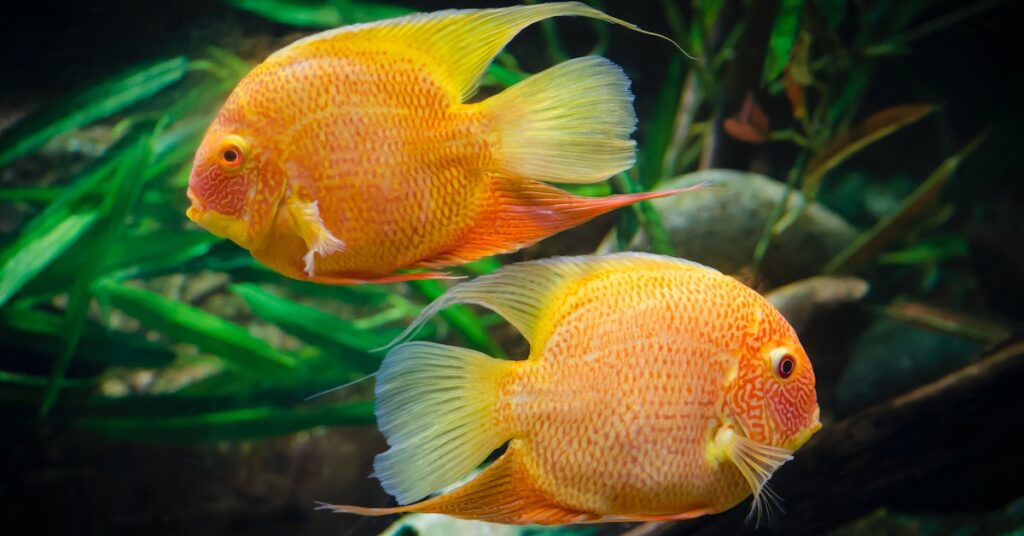There are several reasons why your betta fish may be lying on the bottom of your tank. Some of these reasons include Swim bladder disease, Ammonia poisoning, Age, and Hot water. If you’re worried that your betta might be ill, read on to learn about the most common causes of betta laying on the bottom of your tank. After reading this article, you will be able to figure out what to do next.
Swim bladder disease
If your betta fish lays on the bottom of its tank, it may be suffering from swim bladder disease. This is a serious condition in bettas that can weaken your fish’s immune system and cause a range of symptoms. Symptoms of swim bladder disease include distorted buoyancy, a distended belly, and lack of appetite. In addition to the swim bladder, other organs in the abdomen may be enlarged as well, including the liver and kidneys. During fasting episodes, you can feed your fish-cooked peas. Your vet may prescribe antibiotics for your fish.
The temperature of your betta’s water can also be a contributing factor. Ensure the water temperature is between 78 and 80 degrees Fahrenheit to prevent any infections. If your fish is not swimming, you may need to reduce its water temperature. This can help them digest their food properly. Make sure you feed your betta food before it lays on the bottom of the tank.
If you notice your betta laying on the bottom of the tank, it could be suffering from a disease that affects its swim bladder. These fish may also be suffering from infection or injury, or they may even be resting at the bottom of the tank. Either way, it’s important to treat the tank as soon as possible to save your fish’s life. If the condition is severe, you may need to remove the fish from its tank immediately.
If your betta’s swim bladder is failing to function properly, your betta may start to float to the top or bottom of the tank. It may also float sideways, upside down, or belly-up. The swim bladder is located behind the fish’s internal organs and is shown in blue in the diagram above. This condition can be caused by overeating or poor water conditions. Cool water conditions may slow down your betta’s metabolism, so you’ll want to keep it cooler if possible.
Some symptoms of swim bladder disease include a lopsided body position and difficulty maintaining an upright position. If your betta fish experiences these symptoms, you may also notice that they have constipation. The good news is that you can easily treat this condition. Changing the diet and water temperatures may cure the problem. However, you might need medication if the condition persists. If your betta fish with swim bladder disease is not curable, you can try cutting off its diet for three days.
Read more about How to Take Care of Goldfish
Ammonia poisoning
Ammonia poisoning is a major problem for bettas. Though it is a natural byproduct of fish digestion, this chemical is extremely toxic to fish and should be avoided at all costs. If the ammonia level is high, the best way to treat this problem is to perform a partial water change. To do this, you should remove approximately 25 percent of the water and replace it with new water. Once you have completed this, make sure to monitor the levels of chemicals in the tank.
It is difficult to tell how old a fish is if you didn’t raise them from fry. If you raised them from hatching, they may have spent years in the store or with a breeder before you bought them. If you notice your fish sluggishly laying on the bottom of the tank, it could be near the end of its life. As they age, the waste they produce raises the ammonia level in the tank. Ammonia is toxic to fish and can lead to chemical burns on the gills and eventually to death.
If you’re concerned that your betta may be suffering from ammonia poisoning, you can add an ammonia detoxifier. This is especially effective if your tank is brand-new and you don’t want to risk introducing your fish to an already-toxic tank. This product can be found on Amazon and is very effective. You can also add a dose of SafeStart to the water before adding it to the tank.
A 50% water change can cure your betta’s ammonia poisoning. Do it a couple of days at a time until you reach zero ppm. To prevent your betta from experiencing this problem, make sure to monitor the temperature and limit the amount of food you give them. This treatment can cure the problem, but it is not an instant fix. However, it is one of the most effective ways of protecting your fish from ammonia.
The initial signs of ammonia poisoning in bettas include gasping for air. The fish may also lose their appetite and float about the tank with their fins clamped. If these signs are present, a water change and medical consultation are recommended. So what are the symptoms of ammonia poisoning in betta fish? They include reddish coloration of the gills and a change in the appearance of the betta’s fins.
Read more about How to Take Care of Fish in an Aquarium While on Vacation
Hot water
When your Betta fish is not swimming, you should immediately look for reasons why it might be resting on the bottom of the tank. While some of these reasons are harmless, others may be cause for alarm. Your betta might be injured or poisoned by ammonia, but the majority of them are easily remedied. You can do some basic maintenance to keep your Betta healthy, such as monitoring the tank’s pH levels.
When your betta fish sits on the bottom of the tank, this can be a sign of a problem with its swim bladder. If you notice that their belly is enlarged, he is most likely suffering from swim bladder disease, which can cause him to lay down. Whether this problem is a direct result of a bacterial infection, you should look for a cause for this behavior.
If your betta is laying on the bottom of the tank in hot water, he is not sleeping and is actively looking for food. His breathing is often heavy, which may be a sign of nitrate or ammonia poisoning. This problem can also be caused by too hot water. Your betta needs to move around frequently to feed on fiber-rich foods.
You may also notice your betta fish laying on the bottom of the tank, but it is not likely to be sleeping. This can simply be due to temperature shock. Bettas normally spend around 12-14 hours per day resting, but it is not unusual for them to take naps throughout the day. In any case, you should not worry too much unless you notice unusual behavior.
To keep your betta happy, keep the tank temperature between 82 and 86 degrees Fahrenheit. Change the water regularly and vacuum gravel to keep parasites at bay. You may also need to use medications. A fish with popeye has bulged eyes and may be suffering from poor water quality or environmental factors. The condition is not fatal, but if it is, your betta should be quarantined.
Read more about The Coolest Freshwater Aquarium Fish
Aging
If you’ve noticed that your betta fish have been sitting at the bottom of your tank, there are several causes. These may include water temperature changes in the chemistry of the water. The most common cause is ammonia poisoning. A water change may be necessary to correct the issue. If you suspect a more serious condition, contact a licensed medical expert. In some cases, the betta may simply be laying on its side.
Physical symptoms of aging bettas include lethargy and a lack of enthusiasm. Ideally, your betta would be very active, but as it grows older, it will lay on the bottom of the tank or lay in plants. This sudden change in activity can be a symptom of illness or slow metabolism. Aging bettas may also begin to lose their energy levels and show signs of lowered flaring.
If you notice your betta laying at the bottom of the tank, they may be suffering from a swim bladder problem or other medical condition. If they are laying on the bottom of the tank frequently, you should consider the possibility of a problem with the chemistry of the water and the temperature of the tank. If you notice this behavior, you should take action immediately to ensure your betta’s health. In some cases, the symptoms of aging are symptomatic of poor health, but other times, they are caused by environmental conditions, stress, and age.
While aging bettas usually lay flat on the bottom of the tank, they can also be a warning sign of illness. Their body can not absorb food or move around properly, and they can be difficult to feed and care for. They must also be moved to feed fiber-rich foods. By monitoring these symptoms, you can prevent the betta fish from dying. There are a number of other causes of lethargy and a lack of activity.
Several chemical medications are available to treat a variety of illnesses. Be sure to choose the right medication for your betta, as certain medications are not effective unless the parasites are removed from the betta’s body. A betta can get velvet, also called gold dust disease or rust. This parasite can lead to a decrease in energy, decreased appetite, and difficulty breathing, and the fish may be bumping objects to clear itself of the infection.
Read more about 6 Best Aquarium Filter, You may Buy One







